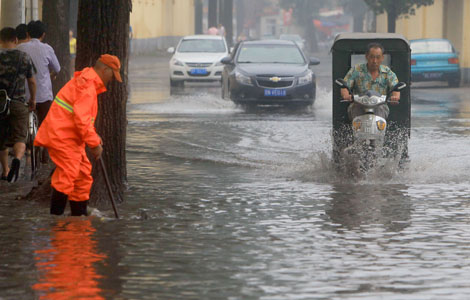Beijing subway standard not realistic, experts say
Updated: 2013-08-10 10:30
By Zheng Xin (China Daily)
|
||||||||
A recent attempt made to relieve crowding on subway cars in Beijing is "impractical and unrealistic", according to experts.
Beijing released its first standards and specifications for a local transit project on Thursday, limiting the spatial density on a subway car to five commuters per sq m at most.
The previous standard was six passengers per square meter.
The standard has also specified that transit between subway transfer lines should take no more than 3 minutes.
According to Liu Xiao, a researcher from Anbound Consulting, an independent think tank dedicated to strategic decision research, the standard sounds ideal, but it won't help heavy commuter congestion.
"It's impossible to count how many people are packed in each subway car, let alone per square meter," he said. "The metro staff cannot drive the commuters off the subway either."
Liu said as most people live far from where they work, subway commuting is inevitable.
"Considering the large amount of passengers, it's a challenge to ensure comfort on public transportation," he said.
Benjamin Zifkin, an exchange student in Beijing from the University of Massachusetts Amherst in the United States, said it's impossible to have five people per square meter on the city's subway.
"It sounds cool, but considering the amount of passengers, the standard seems impossible," he said. "Chicago sees much less people on their subways and transferring lines is much easier."
Zifkin added that the subway is usually smelly and sweaty, especially during rush hour.
If the number limit is enforced, hundreds of people would have to wait in large queues for less crowded cars, he said.
According to the Beijing Administration of Quality and Technology Supervision, the standard is in line with international subway design specifications and aims to relieve commuter congestion.
Experts said the solution to crowded subway cars lies in flexible fares.
Zhang Zhuting, a professor at the Ministry of Transport's Management College, said, "The city should come up with a range of fares in accordance with the length of journey and type of carriage, rather than the set price."
Low ticket prices may attract passengers who may not need to take the subway, and exacerbate the problem, he said.
The capital offers the cheapest public transportation nationwide, with the subway fare set at 2 yuan ($0.33) regardless of mileage, and bus fares at 0.40 yuan.
Ridership on the Beijing subway network has been increasing steadily since March, when the city saw a record 10 million passengers a day.
One reason for the boost lies in the increase in available subway lines in recent years.
Beijing plans to further extend the subway to 19 lines with a track length of 561 km by 2015 and reach 1,000 km by the end of 2020.
In 2002, the city had only two lines with a track length of 54 km.
zhengxin@chinadaily.com.cn

 Spanish skyscraper forgets elevator
Spanish skyscraper forgets elevator
 Beijing rainstorm cancels flights, kills airport worker
Beijing rainstorm cancels flights, kills airport worker
 highs and lows of marine rescue
highs and lows of marine rescue
 Lin Dan wins Olympic final rematch over injured Lee
Lin Dan wins Olympic final rematch over injured Lee
 Northeast China braces for major floods
Northeast China braces for major floods
 High-heeled, well heeled
High-heeled, well heeled
 Thunder storm hits Beijing, darkening the sky
Thunder storm hits Beijing, darkening the sky
 Fans stay away as worlds get off to sweaty start
Fans stay away as worlds get off to sweaty start
Most Viewed
Editor's Picks

|

|

|

|

|

|
Today's Top News
New green policy gives industries a big boost
Northeast China braces for major floods
Launches highlight India's ambitions
Chinese put on alert in Afghanistan
Questioning China's achievements
Go-between helped to cement deal
The only way now is up
Japan to carry out self-defense
US Weekly

|

|





